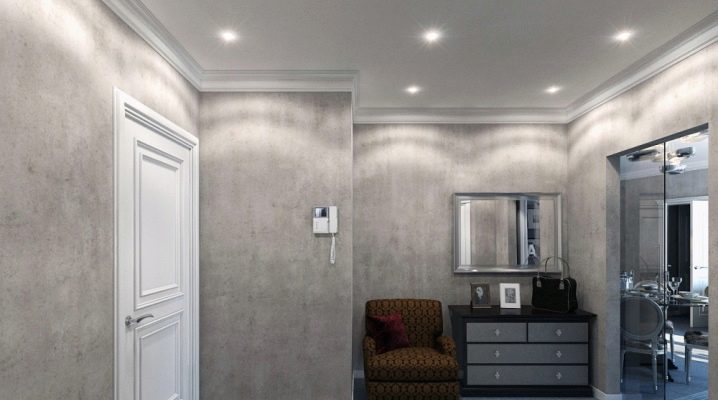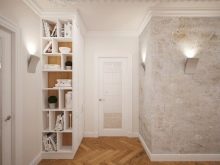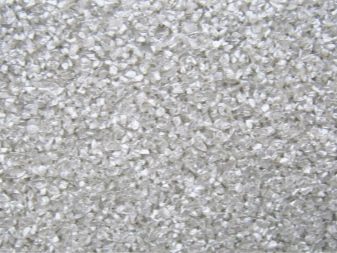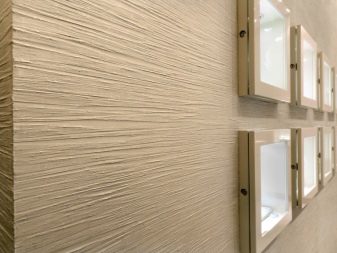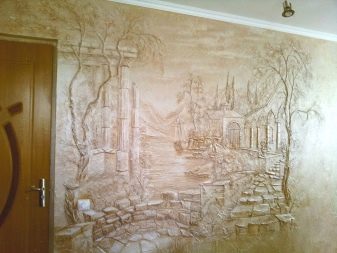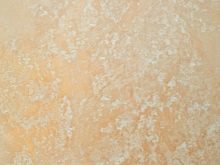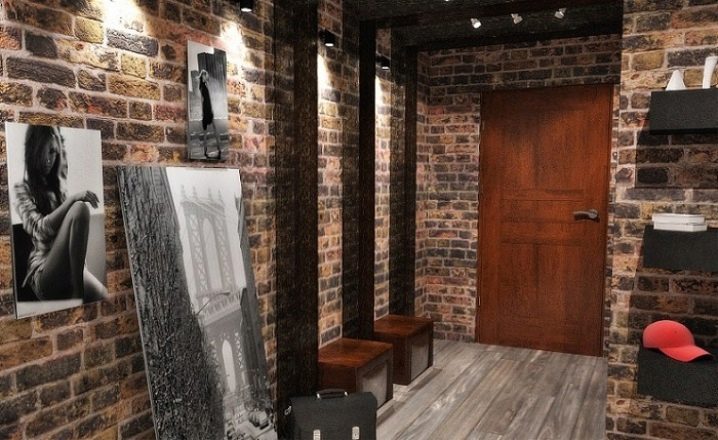Decorative plaster in the hallway
There is a common expression "Theater begins with a hanger." This expression fully conveys the property and purpose of the hallway.
The decoration of the walls in the design and arrangement of the hallway plays no less a role than the choice of suitable furniture. After all, properly selected facing material will visually expand the space, create the right mood, convey the character of the house, and even tell about the respectability of the owners.
Features of design
More recently, it was decided to save on the decorative decoration of the hallway, the main forces were invested in the arrangement and decoration of the "main" rooms - the living room, bedrooms, and kitchens. The walls in the hallway, as a rule, were decorated with wallpaper, laminated or wood panels, and in the budget version - paint.But lately, wall cladding with decorative plaster has become increasingly popular.
This is not to say that this method has appeared recently: way of lining with decorative plaster was actively used in the times of ancient Greece and Rome, archaeologists still find fragments of buildings with a remarkably beautiful preserved surface. For many centuries, decorative plaster has been a worthy decoration of the homes of notable citizens of the whole world. Over time, it lost its relevance, it was replaced by more simple to apply and inexpensive materials.
But it’s not for nothing that they say that everything new is well forgotten old.
The method of decorating the rooms with decorative plaster has returned to everyday use, and today this finishing material, created using the latest technologies, rightly deserves special attention.
Advantages and disadvantages
With this popularity, this type of wall and ceiling lining is obliged, above all, for its practicality and durability. The plastered surface with modern methods retains an attractive appearance for many years, it is easy to clean, resistant to mechanical stress.
Materials applied by a thin layer, allow the walls to "breathe", do not conceal centimeters of space. Even in the smallest hallway, decorative light “marbled” plaster can visually expand the space with its deep shimmer, and the unintentional touches of outdoor shoes or bags will not leave unattractive traces on it, like wallpaper.
Another important advantage for any interior plaster is its ability to imitate any texture. It can be imitation of marble chips, cracks of natural stone, crumpled paper, draping with silk or suede, velor or velvet. With the help of decorative plaster you can create truly unique patterns, unique paintings and color combinations, three-dimensional drawings.
The composition of the decorative plaster includes components of different volume and structure, which provide the surface with a heterogeneous structure. The method of applying the plaster will determine whether the surface is matte or glossy. Proper selection of components will make the walls suitable for any style - from the noble antiquity to the ultra-modern coating with a metallic or neon glow.
Decorative plaster will hide minor defects, it can be applied to any surface of walls: concrete, wood, drywall, and it will create sound insulation. This material is resistant to moisture and fading. In addition, the plaster mix is resistant to fire, which can be a very important factor for private wooden houses.
If desired, the plastered walls of the hallway can be repainted into a new color without changing the texture of the coating. This will update the room, give it a new “sound”. Damaged areas can be reworked without the need to remove the entire coating.
It is only necessary to take into account the difference in shades, so that the reconstructed area after drying dries up with the rest of the surface.
The disadvantages of decorative plaster include the high cost of the material, as well as the need for application technique skills. In addition, for some types of decorative plaster need perfectly smooth walls, special tools and knowledge of a particular technology. But these disadvantages are more than compensated by the fact that your room under the decorative lining will get a truly luxurious and respectable look.It is possible to avoid mistakes in drawing, having ordered performance of work at masters of the business.
Kinds
Before considering this or that type of plaster for facing and decoration of the hallway, it will not be superfluous to classify it visually by type and type.
According to the type of destination, decorative plaster is divided into two types:
- Facade. This type of material is used for cladding buildings, has a dense structure. Most often toxic, therefore not used in residential areas. Facade plaster may contain granite or marble chips (mineral), have the basis of "liquid glass" (silicate), consist of polymers or silicone.
- Interior. This type of plaster differs from the facade more gentle and less resistant substances in the composition.
On the surface relief, decorative plaster can be:
- Textured and smooth (rough surface, different texture, degree of unevenness and application techniques). Heterogeneous granular mass of various shades based on synthetic materials. The composition of this plaster added granules of different origin, depending on the purpose of the final result.It can be a crumb of natural and artificial materials (marble, sand), flax or cotton fibers, wood fiber. The structure can distinguish the main types of textured plaster: bark beetle (imitation of traces of the bug of the same name, grooves in the material), fur coat, silk, rain and lamb (astrakhan).
- Structural or embossed (decorative special effects, imitation of natural materials). The embossed plaster mass applied to the wall can take on any appearance under the influence of special tools (rollers, stampings, stencils). Patterns are molded or cut out on the plastic mass of the material. It is important to give the surface shape and relief before the mixture dries. This type of plaster allows you to create canvases of any artistic content or imitation of the skin of reptiles and is a real find for the imagination of craftsmen and customers.
- Venetian (imitation cut stone). It is considered to be one of the most luxurious and aesthetic coatings in decorative wall decoration. It gives the surface the effect of cutting polished stone. The unique pattern of the vein of marble, malachite, turquoise allows light to penetrate into the depth, causing the surface to glow and glare.
The composition of Venetian plaster is a mixture of stone dust of the rock with which the final result is declared. In addition to marble grains, the mixture may contain quartz, lime, granite. The smaller the stone chips, the thinner and more natural the pattern is.
Depth and "transparency" is achieved thanks to a special application technology.
Patterns for decor
In addition to the basic properties of decorative plaster and methods of its application, there are a number of additional techniques by which you can decorate the surface of the walls in the hallway:
- Stencil drawings. Stencilled painting is one of the fashion trends in the world of modern design. Application technique is to use a pre-made template - stencil. It is used on any type of plastered surface, allows you to make a repeating ornament over the entire surface of the wall or ceiling, as well as a separate panel. Stencil painting can be distinguished by gold leaf or zapatinirovat (artificially aged);
- Volumetric drawings. As a rule, they are made according to a previously prepared sketch, performed with elements of the 3D effect,with a multifaceted perspective and point drawing of small parts. Volumetric drawing can be part of a large wall painting or a separate panel. In the first case, this effect is created only on a specific part of the composition, which significantly reduces the cost of the entire decoration as a whole. It can be various elements of the decor or part of the picture: faces, objects;
- Stone cut. Venetian plaster is capable of creating truly chic interiors thanks to the imitation of light marble, the veins of malachite, the deep glow of various stone rocks;
- Wood. Natural wood lines and rings, or cloths that were torn up like a bark beetle, will decorate hallways not only in country style. They look very warm and cozy thanks to the warm wood shades of plaster;
- Concrete art. This is a stucco technique that imitates untreated concrete. Great solution for loft style;
- The effect of patina. Imitation of patting (aging) will favorably emphasize vintage styles. You can choose any shade of plaster and create a vintage interior in the form of stone walls of the castle, and the effect of rare wood wall cladding.
Options for combining interior trim in the hallway
Decorative plaster is perfectly combined with other building materials, complementing them, and sometimes emphasizing with advantage. The most common combination is the separation of the wall to the top and bottom, where the lower part is lined with more durable materials: wood or laminated panels, tile. Thus, the bottom of the wall is maximally protected from street dirt and the claws of pets, and the upper part will give the room a soft glow and comfort.
With the help of different types of plaster, applied on parts of one wall or on joining walls, it is possible to adjust the width and height of the corridor, to zone the space.
In this case, experiments with color shades and well-chosen lighting angles will also be invaluable.
Which is better to choose?
When choosing decorative plaster, there are several main factors to consider:
- Features of the wall and the possibility of plaster. Some types of facing mixtures are suitable only for perfectly smooth prepared surfaces (for example, Venetian plaster).For walls with small defects, texture is perfect, its granules will hide minor imperfections, it fits perfectly on concrete and brick.
- Temperature conditions The hallway, especially in private homes, is subject to temperature changes due to the opening of the door and the influx of cold air. In such cases, it is better to choose a plaster, which consists of substances resistant to temperature changes. It is worth paying attention to the mixtures containing silicone substances.
- The amount of covered space. The larger the area of the canvas, the greater the financial cost. This factor should be considered before the choice of the mixture. Textured plaster only on the upper part of the wall will be the best option, will not hit the wallet and create a unique design.
Beautiful ideas of interior design in the apartment
If the task is to visually expand the space of the hallway, then it is better to choose light versions of smooth or finely granulated plaster with a discreet pattern in the center. Any relief creates volume, so it will hide even a small space. Smooth stucco with a pattern covering a wall with a thin layer is ideal for small hallways.
For halls and volumetric hallways, you can choose a Venetian finish.The space will play with noble shades, and the hall will resemble the main entrance to the palace. Along with Venetian plaster, stucco and gilding are often used on it, if it does not contradict the style of the room.
Beautifully looks in the corridor plaster, imitating the laying of stone or brick. In combination with the elements of the decor of wire, bare bulbs and fittings, you can create a unique design in the style of a loft.
Volumetric bright drawings fit the interior in the style of pop art. Picturesque paintings will add elegance to the classic style. A gentle color textured plaster enliven the interior in the style of Provence.
Learn more about how to use decorative plaster in the interior of the hallway, you will learn from the following video.
